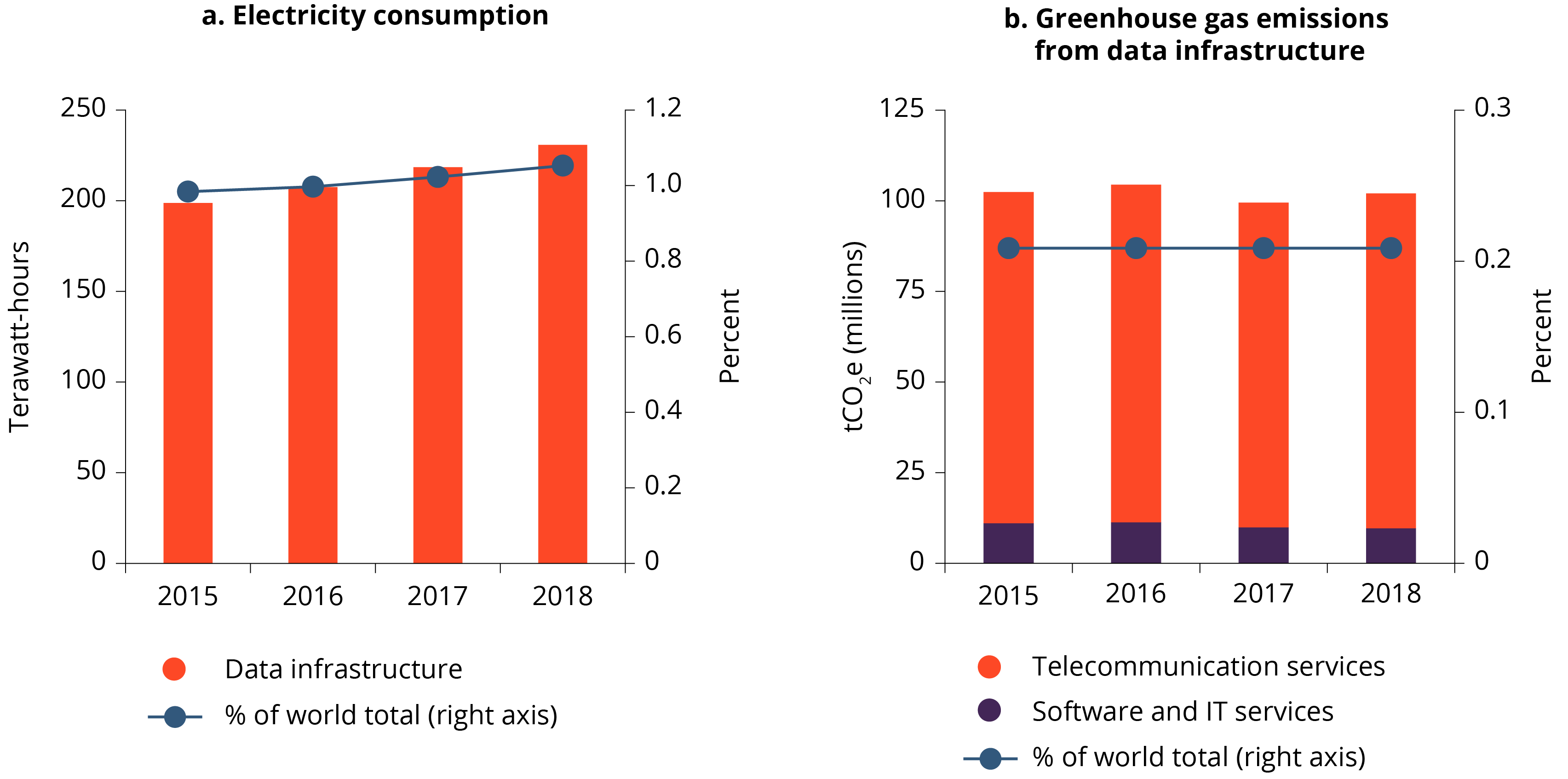Data’s carbon footprint
environment
Data infrastructure is becoming increasingly energy efficient and turning to renewable sources of energy. Increased use of information and communication technology solutions such as videoconferencing could help to reduce global carbon dioxide emissions by one-fifth by 2030.
Data infrastructure consumes significant amounts of energy, with environmental consequences, including global warming. Electricity consumption for data infrastructure amounted to 1 percent of the global total in 2018 (231 terawatt-hours) (figure S5.2.1, panel a). Although data traffic grew 100 percent from 2015 to 2018, associated electricity consumption rose just 16 percent, and its share of total global consumption remains constant. Huge gains in energy efficiency have made this possible. One reason is a shift from smaller data centers to more efficient larger ones, particularly among some of the bigger players in China, Japan, and the United States. Modernization of telecommunication networks is also contributing. Fiber-optic cable is 85 percent more energy efficient than vintage copper wires, while each successive generation of wireless technology conserves more energy than the previous one. For example, 4G can be more than 50 times more energy efficient than 2G.1

Source: World Bank, original research based on annual reports from 49 companies in 26 countries. Figure S5.2.1 data available at the World Bank Data Catalog.
Note: Data were derived from environmental reports of companies accounting for 90 percent of data traffic. IT = information technology; tCO2e= tonnes of carbon dioxide equivalent.
Despite rising electricity consumption, greenhouse gas (GHG) emissions from data infrastructure have been flat since 2015, equivalent to 0.2 percent of the global total (see figure S5.2.1, panel b). This is due to the rising share of renewables in the electricity mix used by data centers.2 For example, Equinix, one of the world’s leading data center operators, increased its share of renewable energy from less than one-third in 2014 to 92 percent in 2018, leading to a two-thirds reduction in GHG emissions.3 Moreover, the tech giants—Apple, Google, and Microsoft—have switched to 100 percent renewable energy, while completely offsetting their GHG emissions. Apple generates more than 600 megawatt-hours of its own energy through one of the largest investments in renewables outside of utility companies,4 while Google is the world’s largest nonutility buyer of renewable energy. Digital companies already account for one-quarter of the world’s renewable energy purchases,5 and they are encouraging their downstream suppliers to follow suit.6
Access to renewable energy is becoming an important factor in deciding where to expand data infrastructure for dozens of major investors. For example, Equinix seeks markets with favorable renewable energy policies when deciding on the location of new data centers.7 Foreign operators are developing renewable energy projects in low- and middle-income nations. For example, Vodafone Group is constructing a utility-scale solar park in the Arab Republic of Egypt.8
Data infrastructure is also playing a significant role in reducing emissions, as demonstrated by the COVID-19 outbreak. The massive use of video conferencing, fueled by the pandemic, has greatly reduced fuel consumption associated with travel—potentially on a permanent basis.9 Increased use of information and communication technology (ICT) solutions could lead to a 20 percent reduction in global carbon dioxide (CO2) emissions by 2030.10 This reduction is almost 10 times greater than the ICT sector’s own footprint during the same period and translates into as much potential emissions reduction as the mobility, manufacturing, agriculture, building, and energy sectors combined.
- IEA (2020).
- There are, nonetheless, some subtleties of environmental accounting. Direct emissions from electricity are reported on either a market basis or a location basis (Equinix 2019). Market basis reflects the emissions from the electricity that a company is purchasing, which may differ from the electricity that the company is using at its location. Location-based emissions are higher, yet most companies report market-based emissions.
- Equinix (2019).
- Apple (2019).
- Ambrose (2020).
- In 2018 Apple announced that 23 of its suppliers had committed to 100 percent clean energy (Apple 2018).
- Nareit (2019).
- Vodafone (2019).
- Darrow (2020).
- GeSI (2015).
- Ambrose, Jillian. 2020. “Tech Giants Power Record Surge in Renewable Energy Sales.” Guardian, January 28, 2020..
- Apple. 2018. “Apple Now Globally Powered by 100 Percent Renewable Energy.” Press Release, April 9, 2018.
- Apple. 2019. “2019 Environmental Responsibility Report.” Apple Inc., Cupertino, CA, April 2019.
- Darrow, Barb. 2020. “Zoom Taps Oracle to Keep Schools Teaching, Businesses Running, Friends and Family Connected.” Oracle News Connect (blog), April 28, 2020.
- Equinix. 2019. “2018 Corporate Sustainability Report: Connecting with Purpose.” Equinix, Redwood City, CA.
- GeSI (Global e-Sustainability Initiative). 2015. #SMARTer2030: ICT Solutions for 21st Century Challenges. Brussels: Global e-Sustainability Initiative.
- IEA (International Energy Agency). 2020. “Data Centres and Data Transmission Networks.” Tracking Report, IEA, Paris, June 2020.
- Nareit. 2019. “REIT Industry ESG Report.” Nareit, Washington, DC, June 2019.
- Vodafone. 2019. “Sustainable Business Report 2019.” Vodafone Group Plc, Newbury, UK.